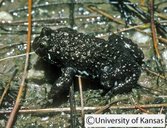|
Poyntonia paludicola Channing & Boycott, 1989
Montane Marsh Frog | family: Pyxicephalidae subfamily: Cacosterninae genus: Poyntonia |
 © 2010 Division of Herpetology, University of Kansas (1 of 1) |
|
|
|
Description The holotype for this species is a male (SVL 29 mm) (Channing and Boycott 1989). The skin on the dorsum and flanks is covered with distinct glandular warts with pale perforations. Warts also occur on the head and limbs, but are smaller and less dense. Some warts even occur on plantar surfaces. A distinct postorbital glandular ridge of tubercles runs from the top of the head, behind the eye, then diagonally backwards to the angle of the jaw. The skin of the gular region is finely granular and lightly pigmented. The skin of the venter and underside of the limbs is lightly pigmented. The anal opening is directed posteroventrally at the upper level of the thighs. The testes have a black pigment and are bean shaped. The hind limbs are short and very robust. The upper arms of the front legs are slightly less robust than the hind legs and the toes are moderately webbed with discs being absent on the digits. The head is slightly narrower than the body. The snout appears to be bluntly rounded when viewed from the side and is truncate in profile. The nostrils are raised and rimmed, and the eyes are moderate in size, protruding above the head, with horizontal pupils. The choanae are round and the choanal diameter/interchoanal distance is 0.25. The tongue is in length more than twice its width and is notched posteriorly. There are no median papillae and vocal slits are absent. The tympanum are invisible. A raised glandular area behind each eye resembles the parotoids of a bufonid, caused by a well developed muscle covered by a thin layer of skin. The top of the head, the body, and the upper side of the limbs are a dark grayish brown color. A pale to reddish vertebral stripe was seen in some individuals catalogued by Channing and Boycott (1989). A distinct white ridge occurs from the eye to the angle of the jaw. The underside of the body is pale and can be creamy to heavily flecked. The undersides of the limbs are flecked. Distribution and Habitat Country distribution from AmphibiaWeb's database: South Africa
This species resides in shallow seepage zones, shallow streams along rocky outcrops, and marshy areas away from larger streams, river dams, or lakes. All preferred habitats occur on the upper slopes of the mountains of the southwestern Cape Province in South Africa (Channing and Boycott 1989). Seepage zones appear to be its optimal habitat, especially those characterized by low, water-loving bushes, grass tussocks, and clumps of reeds where the water depth remains constantly shallow (Boycott 1990). Life History, Abundance, Activity, and Special Behaviors Trends and Threats Possible reasons for amphibian decline Floods
References
Boycott, R. (1990). ''A new frog from the south-western Cape Province.'' African Wildlife, 44(6), 343-346. Channing, A. and Boycott, R. C. (1989). ''A new frog genus and species from the mountains of the southwestern Cape, South Africa (Anura: Ranidae).'' Copeia, 1989(2), 467-471. Originally submitted by: Kory Heiken (first posted 2005-10-25) Edited by: Kory Heiken, Kellie Whittaker (2008-02-03) Species Account Citation: AmphibiaWeb 2008 Poyntonia paludicola: Montane Marsh Frog <https://amphibiaweb.org/species/3819> University of California, Berkeley, CA, USA. Accessed Jun 2, 2025.
Feedback or comments about this page.
Citation: AmphibiaWeb. 2025. <https://amphibiaweb.org> University of California, Berkeley, CA, USA. Accessed 2 Jun 2025. AmphibiaWeb's policy on data use. |


 Map of Life
Map of Life